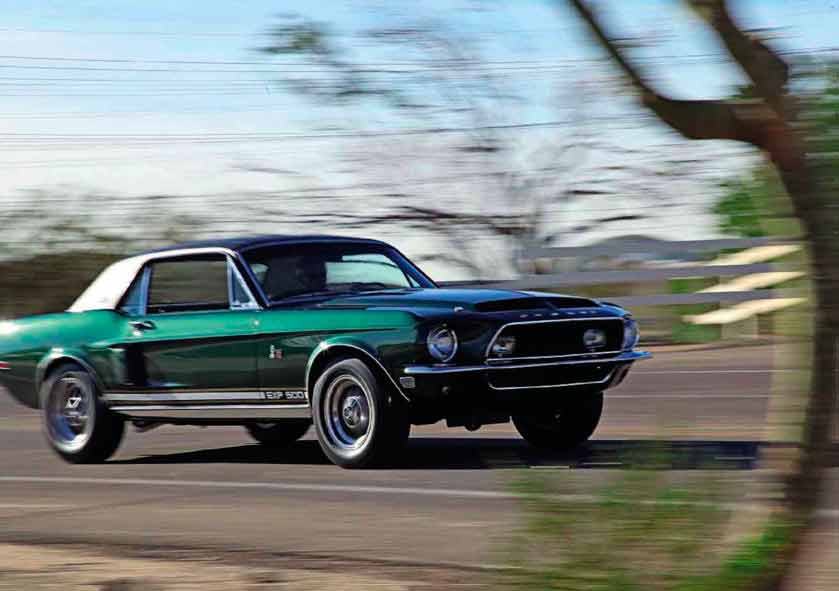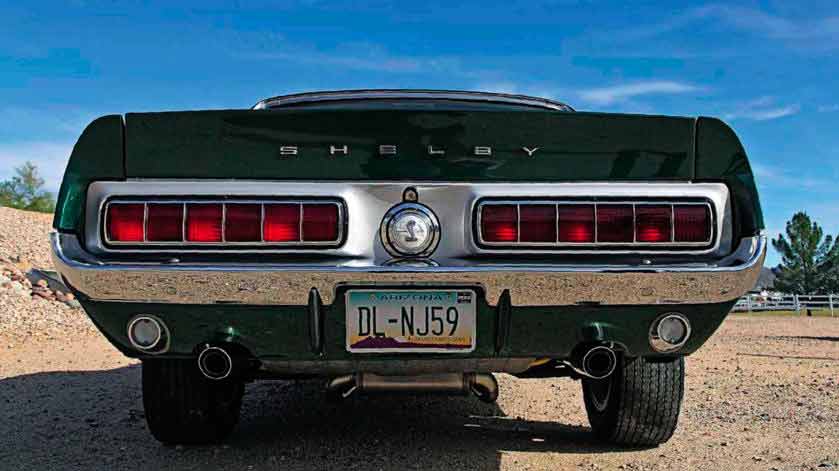
This is no ordinary Mustang. A one-off created by Shelby American and dubbed The Green Horne t by superstar Bill Cosby, it was bid to $1.8m at auction – yet still didn’t sell. Here’s why. Words and photography Winston Goodfellow.
‘GREEN HORNET’ MUSTANG
Driving world’s most coveted Ford Mustang: a Shelby prototype
One in several MILLION
Are you ready?’ With those three words Craig Jackson (co-founder of Barrett-Jackson Auctions) instigated one of the more memorable moments I’ve had while photographing a car. We were in the midst of proceedings when he unexpectedly came to a stop and uttered that phrase.
‘Underneath that vibrant green paint is a veritable testbed of Yankee ingenuity’

As I stood on the side of the road bewildered, he mashed the throttle. The tyres on the Green Hornet – a one-off Shelby Mustang with a two-comma price tag – began spinning furiously, a cloud of rubber-induced smoke billowing out from the back. Jackson flashed a mischievous grin, released the brake, and the Hornet shot off with a thundrous roar, the tyres chirping with each upshift of the car’s experimental automatic transmission.
‘The motor’s displacement was punched far beyond the normal 428 cubic inches’
Right now a few questions are likely running through your head. ‘What in God’s name is the Green Hornet?’ quickly followed by ‘How can any Mustang carry a two-comma price tag?’ and leading to ‘Why would anyone light up the tyres on a prized possession just days before it is a starring lot in their own auction?’
Let’s tackle the first two queries. Certain countries have their star marques, those manufacturers engulfed in mystique. In the UK, the names are Aston Martin, Jaguar and Bentley; Germany has Porsche and Mercedes-Benz; Italy Ferrari, Maserati and Alfa Romeo. The glue that holds these greats together is their innumerable racing triumphs on home turf and the international stage, culminating with Le Mans victories and/or world championship trophies. Plus they are all well known for their custom coachwork and limited production models.

In America, the one marque that ticks all those boxes is Shelby American. Carroll Shelby’s Cobra burst onto the scene in 1962, and within three years the Daytona Coupes captured the FIA crown. Then, from 1965 to ‘1967, the only Ford GT40s that chalked up victories at Le Mans, Daytona and Sebring were Shelby-prepped.
On the US side of the Atlantic the mystique didn’t stop there, as Carroll and co turned the nascent muscle car scene on its head. In 1964 Ford wanted its recently released and selling like-gangbusters Mustang to be recognised as a sports car, and approached the Sports Car Club of America (SCCA) to have it designated as such. SCCA racing was highly influential back then, with major players such as Corvette, Jaguar, Porsche and Shelby’s Cobras competing regularly.
Imagine Ford’s surprise when they were rebuked… So company star Lee Iacocca turned to Carroll to apply his magic to the Mustang. Shelby called SCCA head John Bishop, asking what it would take to transform Ford’s newest into a sports car so it could go racing. He got his answer (two seats, modifications to the engine or suspension but not both), and handed the project to test driver Ken Miles and ace troubleshooter Phil Remington. Then Chuck Cantwell joined Shelby as Mustang project engineer, Ford debuted its lovely 2+2 fastback, and Pete Brock created what is possibly the most famous graphics package ever put on a car.
In early 1965 after several months of intense development, Shelby’s new GT350 won its first ever race. From that point on E-types, Corvettes and everything else saw nothing but taillights, and GT350s won the SCCA’s prestigious B/Production class championship three years in a row.
Shelby also built a small run of GT350 convertibles in 1966, and won the inaugural Trans Am championship that year. In 1967 Shelby picked up its second Trans Am crown, all while giving the GT350 new bodywork and a 7.0-litre brother, the GT500.
Carroll’s continual quest for speed saw the Paxton supercharger remain an option on the newly styled 4.7-litre GT350, and a trick one-off notchback GT500 affectionately named ‘Little Red’ was fitted with one too. Amazingly, it wasn’t the fastest Shelby Mustang, as the GT500 Super Snake (powered by a race-spec 427) cleared 170mph while testing at Goodyear’s Texas facility. The proposed 50-unit production run never materialised, and the Super Snake remained a one-off.
If this kind of ‘gotta go faster’ mechanical tinkering, with short-run production models and one-offs, sounds familiar, it should – in Italy such street cars were known as Speciales and fuori serie models, and the men who made them there and in southern California lived and thrived in the same type of automotive culture. To wit: in central Italy, tests and competitions were held at the Aerautodromo di Modena; in southern California, the dry lakes and local circle tracks. The auto industries in both locations had massive infusions of sophisticated aircraft technology following World War Two, when ex-military craftsmen looked for places to apply their skills.
That and more lured employees from all corners of the world to be part of the special working atmosphere fostered by such charismatic leaders as Carroll Shelby, Enzo Ferrari and Ferruccio Lamborghini. When Cobra production was in full swing, Shelby racer John Morton would blow off going to the movies with friends so he could head back to the factory. ‘I would come in after dinner,’ he remembers, ‘and those employees that were of any value [always] had something going on they had to get finished. I would come back just to watch them.’
Compare this with what engineer Gianpaolo Dallara says about his years at Lamborghini (1963-1968), which coincidentally overlap much of the Shelby story: ‘We were [at the factory] all the time. It was so exciting and happily we did not realise how difficult it was!’
So they thought the same way, and each organisation had its own master mechanical magician. Dallara created the Miura from scratch, all while marvelling at how Maserati chief engineer Giulio Alfieri could ‘create something from nothing’. At Shelby the go-to man was Phil Remington. He could create a component or solve any problem, usually the first time he tackled the task.
Such common threads weave their way through the great marques, and form the basis of why cars such as the Green Hornet command two-comma prices. There are other reasons, the most obvious to Shelby fans being the muscular coachwork: the Hornet was one of only two Shelby notchback coupes (the other being Little Red, which no longer exists, so in that sense the Hornet is a one-off). It also served as the second coachwork prototype for a limited production Mustang model, the GT/ CS, with Shelby modifying the Hornet to use the GT350/500 hood and front end.
Underneath that vibrant green paint is a veritable testbed of Yankee ingenuity. America has long believed ‘there is no substitute for cubic inches’, and at first glance the Green Hornet appears to follow the same route as the GT500 KR (its big-block stablemate) by using a 428 (7.0-litre) Cobra Jet. That mighty V8 (grossly underrated at 335 horsepower) transformed Ford’s performance on the street, but when you lift the bonnet and start poking around in the engine compartment, significant differences appear.
‘That’s because it’s a CJ-X engine,’ Craig Jackson explains. ‘The “X” meant experimental, and a Conelec fuel-injection unit was used in place of the Holley carburretor. The block was also modified, punching the motor’s displacement far beyond the normal 428 cubic inches.’ A ‘normal’ 428 displaces a capacity of no less than 7014cc…
The result? Gonzo horsepower, more than the standard C6 automatic transmission could handle. ‘Shelby’s chief engineer at the time was Fred Goodell,’ says Jackson, ‘and from his experience with Little Red he knew this spelled trouble, so they custom-made their own heavy-duty automatic transmission. It has a torque converter from Lincoln [a division of Ford], and a cast-iron tailhousing created by Bob Smith, the chief engineer of Ford’s transmission department.’
At the back is the most intriguing modification: an independent rear suspension with A-arms and coil springs. ‘Shelby moved from southern California to Michigan for 1968’s production,’ Jackson says, ‘so Goodell designed the IRS where the components are set in a cradle that fits into the pick-up points for the production Mustang’s solid rear axle. This way, the IRS could be put in place on the assembly line in Detroit, should it have gone into production.’
All this added up to world-class performance. The four-seat Green Hornet was tested at Ford’s proving grounds in Michigan, and with a 3.00:1 final drive it hit 60mph in 5.7 seconds, 100mph in 11.4, and averaged 157mph over four laps. For comparison, a Vantage-spec Aston DB6 and Ferrari 365 2+2 needed 6.1 and 7.8 seconds for 60mph, 15 and 20.8 seconds to 100mph, and topped out at 148 and 152mph, respectively.
Just days before his 2013 auction, Jackson took a break from his nutso schedule to play with his historic Shelby. Once behind the wheel, he pins the pedal to the metal and grins like a 50-year-old kid. You soon discover he’s an enthusiast’s enthusiast, and as he whips through a fast right-hand sweeper he casually notes: ‘She likes to be driven hard.’ No kidding, and I’m dumbfounded by how little body roll the car exhibits, while the exhaust growls and the slashing acceleration continues unabated.
Several minutes later Jackson pulls over for that impressive display of melting the tyres. Then he says: ‘Your turn!’ I slip behind the wheel, mindful that the Green Hornet is about to come up for auction. There’s excellent head- and legroom, and the seat is quite comfortable but lacks any side bolstering. Period luxury touches include stitched leather and liberally applied wood panels, even in places you don’t expect such as the strip down the centre of the headlining.
The cabin is quite airy and there’s great visibility in every direction. The commanding view out over the hood is fabulous, the bonnet’s vents hinting at the serious power under your right foot. But it’s too bad this car doesn’t have a proper three-spoke steering wheel like that found in the ‘1967 Shelbys, to suit its sporting nature.
The Green Hornet is docile at low speeds, the ride firm but not jarring. The power steering is light and needs one hand (not one finger like a Cadillac) to turn, which masks the weight of the mighty powerplant up front. That marvellous visibility makes it easy to place the car on the road whether you’re going fast or slow, though you will likely be doing more of the former than the latter. Mash the throttle and the Hornet gets up and goes, the engine feeling so smooth that for a good portion of our drive I accidentally leave the lever in second without realising it.
When exercising the accelerator the cabin is bathed in the most delicious deep growl from the engine and exhaust, with neither overpowering the other. It’s an intoxicating duet, seducing you, begging you to run the Shelby hard through the gears again and again. So I comply and slow down, pin the accelerator once more and notice how the transmission jerks on upshifts, giving a slight thonk when it slots into the next gear.
That nudge in the back is part of the car’s charm, as you sense the results of experimentation, that feel of history as the development team searched for solutions. In fact, that momentary delay reminds me of the paddleshift tranny in the Ferrari FX built for the Brunei Royal family in the mid-1990s. That too was an experimental unit, built by Williams F1 of all things, but unlike the Ferrari the Shelby delivers a nice tyre chirp with each shift, adding to the boy-racer appeal that was mesmerising America’s youth (and adults) at the time.
With the auction just days away I never push the Hornet hard through comers, as much as I want to. The power brakes are quite grabby, with initial pedal travel being immediately followed by quick bite that is greater than you expect. At higher speeds the Shelby feels quite stable and, if it were running on a decent set of tyres (these were fiat-spotted with age), there’s no question the Hornet would pin its 140mph speedometer with ease.
Those looks, that heritage, the intriguing mechanicals, rarity, and such monstrous performance make the Green Hornet one highly charismatic and desirable machine. If this were a comparable Ferrari, Maserati, Bentley or Aston, in similar condition, it would command a price tag a multiple or two higher than the $1.8 million it was bid to at the auction. ‘That sum wasn’t enough for me to let it go,’ Jackson says. ‘At that price, there is nothing out there that gives me all the attributes this car has, that is that significant. So I am going to continue enjoying it.’
He’s not alone. A number of the big boys I have spoken with who are being offered incredible amounts of money for their machinery have found themselves in the same predicament. Sure, Jackson could get a perfect Ferrari 275GTB/4, or a Daytona Coupe and Spider, but those are mundane compared with the one and only Shelby Green Hornet.
TECHNICAL DATA FILE SPECIFICATIONS 1968 Shelby Green Hornet
ENGINE 7000c+c V8, OHV, Conelec fuel injection
MAX POWER 455bhp @ 5600rpm / DIN
MAX TORQUE 505lbft @ 2900rpm / DIN
TRANSMISSION Shelby-modified C6 three-speed automatic, rear-wheel drive
STEERING Power-assisted recirculating ball
SUSPENSION Front: coil springs over upper control arm, telescopic dampers, anti-roll bar. Rear: fully independent IRS with separate subframe, coil springs, telescopic dampers, lateral bar, anti-roll bar BRAKES Discs
WEIGHT 1790kg
PERFORMANCE Top speed 157mph 0-60mph 5.7sec
Right and below Auction-house founder Craig Jackson behind the prosaic two-spoke steering wheel of the unique Mustang he decided to keep after bidding reached $1.8m; that V8 is tweaked beyond the usual 7.0-litre capacity… Above and below Stitched leather-trim and extra dials make quiet hints about the specialness of the Green Hornet, but it’s subtle stuff; the automatic transmission had to be beefed-up by Shelby’s engineers to cope with the additional torque.






